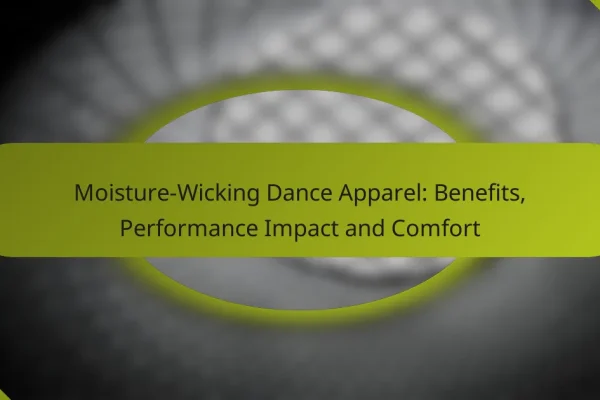What are the key functionalities of dancewear?
Dancewear is designed to enhance performance through support, flexibility, and comfort while also being stylish. Key functionalities include moisture-wicking properties, durability, and a fit that allows for unrestricted movement.
Support and flexibility
Support and flexibility are crucial for dancewear, as they help dancers perform movements safely and effectively. Fabrics like spandex and Lycra provide the necessary stretch while maintaining support for the body. Look for garments that offer reinforced seams and strategic paneling to enhance both support and flexibility.
Moisture-wicking properties
Moisture-wicking properties are essential in dancewear to keep dancers dry and comfortable during intense sessions. Fabrics designed to pull sweat away from the skin help regulate body temperature and reduce the risk of chafing. When selecting dancewear, prioritize materials labeled as moisture-wicking for optimal performance.
Durability and longevity
Durability and longevity are important factors in dancewear, as frequent use can lead to wear and tear. High-quality fabrics and construction techniques can extend the life of dance garments, making them a better investment. Consider brands that offer warranties or guarantees on their products to ensure you are getting durable dancewear.
Comfort and fit
Comfort and fit are paramount in dancewear, as ill-fitting clothing can hinder movement and distract from performance. Look for items that provide a snug yet comfortable fit, allowing for a full range of motion. Always try on dancewear before purchasing to ensure it meets your comfort standards and fits your body shape well.
Style and aesthetic appeal
Style and aesthetic appeal play a significant role in dancewear, as dancers often express their individuality through their clothing. Choose designs, colors, and patterns that resonate with your personal style while still meeting functional needs. Keep in mind that some dance studios may have specific dress codes, so ensure your choices align with those requirements.
How does dancewear enhance performance?
Dancewear enhances performance by providing the necessary support, flexibility, and comfort that dancers need during practice and performances. The right clothing can significantly improve movement efficiency and overall effectiveness in dance routines.
Improved range of motion
Dancewear is designed to allow for a full range of motion, which is crucial for executing various dance movements. Fabrics with stretch properties, such as spandex or Lycra, enable dancers to perform high kicks, deep lunges, and intricate choreography without restriction.
When selecting dancewear, look for items that fit snugly but comfortably, ensuring they do not hinder movement. Styles like leotards, tights, and fitted tops are ideal for maximizing mobility.
Enhanced breathability
Breathability in dancewear is essential for maintaining comfort during intense physical activity. Fabrics that wick moisture away from the body help regulate temperature and keep dancers dry, which can improve focus and performance.
Opt for dancewear made from moisture-wicking materials, such as polyester blends or specialized performance fabrics. This will help prevent overheating and allow for longer practice sessions without discomfort.
Reduced risk of injury
Wearing appropriate dancewear can help reduce the risk of injury by providing support and protection to the body. For instance, fitted clothing can help prevent chafing and irritation, while supportive footwear can minimize strain on the feet and ankles.
To further reduce injury risk, consider layering dancewear for added support, such as wearing supportive leggings or shorts over tights. Always ensure that your dancewear fits properly to avoid any potential hazards during movement.
What types of dancewear are available?
Dancewear comes in various styles tailored to different dance forms, each designed for comfort, flexibility, and aesthetic appeal. Common types include ballet leotards, jazz pants, contemporary dance dresses, and hip-hop outfits, each serving specific functional and stylistic purposes.
Ballet leotards
Ballet leotards are form-fitting garments that provide support and freedom of movement for dancers. Typically made from stretchy materials like cotton or spandex, they allow for a full range of motion while showcasing the dancer’s lines and technique.
When choosing a ballet leotard, consider factors such as fit, color, and style. Classic colors like black, pink, and white are popular, but many dancers opt for vibrant hues to express their personality. Ensure the leotard has a comfortable neckline and sufficient coverage for ease of movement.
Jazz pants
Jazz pants are loose-fitting trousers designed for jazz dance, offering both comfort and flexibility. They are usually made from breathable fabrics that allow for easy movement and are available in various lengths, from full-length to capri styles.
When selecting jazz pants, look for features like an elastic waistband and moisture-wicking materials. These pants should fit snugly at the waist but allow for ample movement in the legs. Pairing them with a fitted top can create a balanced silhouette that enhances performance.
Contemporary dance dresses
Contemporary dance dresses combine elegance with functionality, often featuring flowing fabrics that enhance movement. These dresses can vary widely in style, from fitted bodices to loose skirts, allowing dancers to express their artistic vision.
When choosing a contemporary dance dress, consider the fabric’s weight and drape, as these factors affect how the garment moves with the body. Look for dresses that allow for layering or have adjustable features to accommodate different dance styles and personal preferences.
Hip-hop outfits
Hip-hop outfits are characterized by their urban style and comfort, often incorporating baggy pants, graphic tees, and sneakers. These outfits allow for dynamic movement and self-expression, reflecting the culture of hip-hop dance.
When selecting hip-hop attire, prioritize comfort and fit. Loose-fitting clothing made from durable materials is ideal for the energetic movements typical in hip-hop. Accessories like caps and oversized jackets can enhance the overall look while providing additional comfort during performances.
What factors should be considered when choosing dancewear?
When selecting dancewear, consider body type, the specific dance style, fabric quality, and brand reputation. Each factor significantly influences comfort, performance, and durability during practice and performances.
Body type and fit
Choosing dancewear that complements your body type is crucial for both comfort and performance. Different styles, such as leotards or leggings, may fit differently based on body shape, so it’s essential to try on various options to find the best fit.
Look for dancewear that provides adequate support and flexibility, allowing for a full range of motion. Pay attention to sizing charts, as brands may vary in their measurements.
Type of dance
The type of dance you practice will dictate the style and functionality of your dancewear. For instance, ballet dancers often wear tights and leotards, while hip-hop dancers might prefer looser-fitting clothing for ease of movement.
Consider the specific requirements of your dance style, such as the need for additional support or breathability, to ensure your attire enhances your performance rather than hinders it.
Material and fabric
The choice of material is vital for comfort and durability in dancewear. Fabrics like cotton, spandex, and polyester are popular due to their stretchability and moisture-wicking properties.
Look for breathable materials that allow for airflow, especially during intense practice sessions. Avoid fabrics that may cause chafing or restrict movement, as these can lead to discomfort.
Brand reputation
Brand reputation can be a reliable indicator of quality in dancewear. Established brands often have a history of producing durable and well-fitting attire that meets the needs of dancers.
Research customer reviews and seek recommendations from fellow dancers to find brands that are known for their quality and performance. Investing in reputable brands can save you money in the long run by reducing the need for frequent replacements.
How does dancewear vary by dance style?
Dancewear varies significantly by dance style, as each genre has unique requirements for movement, flexibility, and aesthetics. For instance, ballet attire emphasizes form and structure, while hip-hop clothing prioritizes comfort and freedom of movement.
Ballet
Ballet dancers typically wear leotards, tights, and ballet slippers, which allow for a full range of motion and showcase the dancer’s lines. The fabric is often stretchy and breathable, providing support without restricting movement. For performances, tutus and pointe shoes are common, enhancing the visual appeal of the dance.
Jazz
Jazz dancewear is more varied and can include fitted tops, jazz pants, and character shoes. The clothing is designed to allow for quick movements and flexibility, often made from materials that wick moisture away. Dancers may also wear accessories like hats or scarves to enhance their performance style.
Hip-Hop
Hip-hop dancewear focuses on comfort and personal expression, often featuring loose-fitting clothing such as baggy pants, oversized shirts, and sneakers. Fabrics are typically durable and allow for a wide range of motion. Bright colors and bold patterns are common, reflecting the energetic nature of the dance style.
Contemporary
Contemporary dancewear combines elements from various styles, often featuring form-fitting attire like leotards or flowing skirts. The emphasis is on ease of movement, so materials are chosen for their flexibility and comfort. Dancers may also layer their outfits to create visual interest during performances.
Tap
Tap dancers wear shoes with metal plates that create sound when they strike the floor. Clothing is usually fitted to allow for visibility of the footwork, often including tailored pants and tops. The choice of attire can vary widely, but comfort and style are key considerations.










